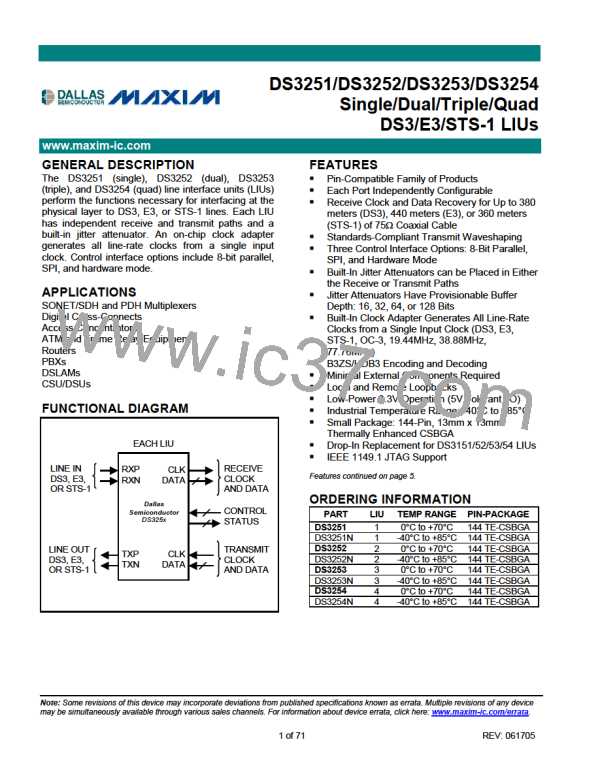DS3251/DS3252/DS3253/DS3254
The requirements of ITU-T G.775 for E3 LOS defects are met by a combination of the ALOS detector and the
DLOS detector, as follows:
For E3 RLOS Assertion:
1) The ALOS detector in the AGC/equalizer block detects that the incoming signal is less than or equal to a signal
level approximately 24 dB below nominal, and mutes the data coming out of the clock and data recovery block.
(24 dB below nominal is in the “tolerance range” of G.775, where LOS may or may not be declared.)
2) The DLOS detector counts 175 M75 consecutive zeros coming out of the CDR block and asserts RLOS. (175
M75 meets the 10 ? N ? 255 pulse-interval duration requirement of G.775.)
For E3 RLOS Clear:
1) The ALOS detector in the AGC/equalizer block detects that the incoming signal is greater than or equal to a
signal level approximately 18dB below nominal, and enables data to come out of the CDR block. (18dB is in
the “tolerance range” of G.775, where LOS may or may not be declared.)
2) The DLOS detector counts 175 M 75 consecutive pulse intervals without EXZ occurrences and deasserts
RLOS. (175 M 75 meets the 10 ? N ? 255 pulse-interval duration requirement of G.775.)
The DLOS detector supports the requirements of ANSI T1.231 for STS-1 LOS defects. At STS-1 rates, the time
required for the DLOS detector to count 175 M 75 consecutive zeros falls in the range of 2.3 ? T ? 100ꢂs required
by ANSI T1.231 for declaring an LOS defect. Although the time required for the DLOS detector to count 175 M 75
consecutive pulse intervals with no excessive zeros is less than the 125ꢂs–250ꢂs period required by ANSI T1.231
for clearing an LOS defect, a period of this length where LOS is inactive can easily be timed in software.
During LOS, the RCLK output pin is derived from the LIU’s master clock. The ALOS detector has a longer time
constant than the DLOS detector. Thus, when the incoming signal is lost, the DLOS detector activates first
(asserting the RLOS pin or bit), followed by the ALOS detector. When a signal is restored, the DLOS detector does
not get a valid signal that it can qualify for no EXZ occurrences until the ALOS detector has seen the signal rise
above a signal level approximately 18dB below nominal.
8.6 Framer Interface Format and the B3ZS/HDB3 Decoder
The recovered data can be output in either binary or bipolar format. To select the bipolar interface format, pull the
RBIN pin low (hardware mode) or clear the RBIN configuration bit in the RCR register (CPU bus mode). In bipolar
format, the B3ZS/HDB3 decoder is disabled and the recovered data is buffered and output on the RPOS and
RNEG outputs. Received positive-polarity pulses are indicated by RPOS = 1, while negative-polarity pulses are
indicated by RNEG = 1. In bipolar interface format, the receiver simply passes on the received data and does not
check it for BPV or EXZ occurrences.
To select the binary interface format, pull the RBIN pin high (hardware mode) or set the RBIN configuration bit in
the RCR register (CPU bus mode). In binary format, the B3ZS/HBD3 decoder is enabled, and the recovered data is
decoded and output as a binary value on the RDAT pin. Code violations are flagged on the RLCV pin. In the
discussion that follows, a valid pulse that conforms to the AMI rule is denoted as B. A BPV pulse that violates the
AMI rule is denoted as V.
In DS3 and STS-1 modes, B3ZS decoding is performed. RLCV is asserted during any RCLK cycle where the data
on RDAT causes ones of the following code violations:
CꢀHardware mode or ITU bit set to 0
–
–
–
A BPV immediately preceded by a valid pulse (B, V).
A BPV with the same polarity as the last BPV.
The third zero in an EXZ occurrence.
CꢀITU bit set to 1
–
–
A BPV immediately preceded by a valid pulse (B, V).
A BPV with the same polarity as the last BPV.
25 of 71

 DALLAS [ DALLAS SEMICONDUCTOR ]
DALLAS [ DALLAS SEMICONDUCTOR ]